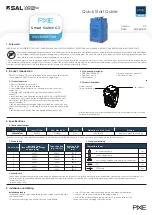
52
Zugriff aus eigenen Anwendungen
Switching the own outputs
The outputs can be switched to ON or OFF. Another possibility is to toggle the exist-
ing state.
Alternatively, several outputs can be switched simultaneously. For each selected
output, you can specify whether it is to be set to ON or OFF.
Switching the outputs of another Web-IO
Also in this case, either one specific output or several outputs can be switched.
Specify the IP address of the Web-IO at which the outputs are to be switched.
Specify the TCP port set as the browser access port for the destination Web IO. If
the target Web-IO is protected with a password, this must also be entered.
For the destination Web-IO
Allow HTTP requests
must be enabled (
Communication
paths » Web-API
) and the controlled outputs for switching from the browser and HTTP
must be enabled.
The outputs of the older Web-IOs models #57630, #57631, #57634 und #57637 can
also be switched. In this case the HTTP port of the Web-IO must be specified as the
TCP port. The outputs must be set in
Output Mode
Menu.
Switching outputs as an action offers many interesting application possibilities.
Point-to-Point connection
Similar to box-to-box connections where the inputs on Web-IO A are mapped 1:1 to
the outputs on Web-IO B, the switching state of one input can be mapped to any
desired output on another Web-IO.
Point-to-Multipoint
By creating multiple actions which use an input as initiator, correspondingly more
outputs on different Web-IOs can be controlled.









































